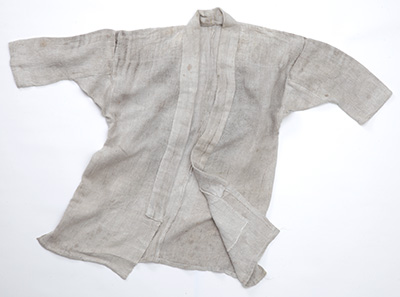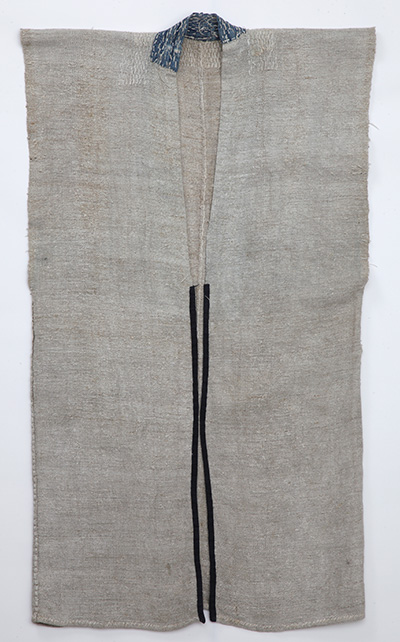
Category
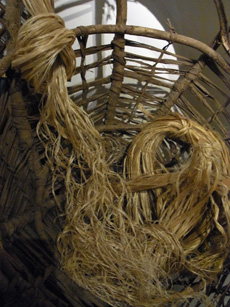
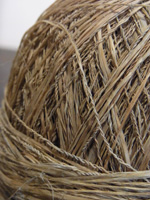
- 麻:大麻、苧麻 -
日本で通称「麻」と言われているのは大麻と苧麻である。大麻と苧麻は、木綿が普及し だしても、しばらくは日本人にとっては、身近な存在であった。
大麻は一年草でクワ科に属する。苧麻はイラクサ科の多年草で、毎年焼畑をし て新芽を出して育てる。
大麻
特に大麻は、古代から神聖な糸として、天皇の政や神事に用いられていた。同 時に、庶民の日常着や生活道具、あるいは武士階級の衣服にも使われていて、 非常に幅広い表情を持った布であった。
その要因は、糸の太さや、晒し方等でさまざまに変化する素材であるという事 に起因する。人々はその事を熟知して、用途別によって、自在に使い分けてい た。
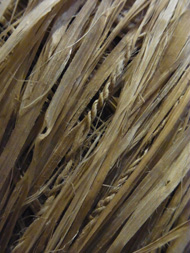
日本で通称「麻」と言われているのは大麻と苧麻である。大麻と苧麻は、木綿が普及し だしても、しばらくは日本人にとっては、身近な存在であった。
大麻は一年草でクワ科に属する。苧麻はイラクサ科の多年草で、毎年焼畑をし て新芽を出して育てる。
大麻
特に大麻は、古代から神聖な糸として、天皇の政や神事に用いられていた。同 時に、庶民の日常着や生活道具、あるいは武士階級の衣服にも使われていて、 非常に幅広い表情を持った布であった。
その要因は、糸の太さや、晒し方等でさまざまに変化する素材であるという事 に起因する。人々はその事を熟知して、用途別によって、自在に使い分けてい た。

- Asa: Taima,Choma -
Hemp and Ramie
Hemp and ramie are two kinds of plant bast fibers.
They are also known as asa in Japan.
Asa was still in use when cotton started spreading throughout Japan.
Taima,Hemp
Hemp belongs to the mulberry family. It takes up to a year for the plant to mature.
Hemp thread was considered sacred in old Japan. It was used for making garments worn by emperors for use at political events and festivities. Simultaneously, hemp cloth was also used for making clothes worn by common people, feudal lords and warriors, as well as for everyday use, such as string for tying packages.
Hemp’s relative flexibility depends on the thickness of the thread and from its exposure to the sun. People’s knowledge of hemp’s broad utilitarian applications led to many ways of using different weights and grades of hemp threads in the creation of various everyday, utilitarian items.
Hemp and Ramie
Hemp and ramie are two kinds of plant bast fibers.
They are also known as asa in Japan.
Asa was still in use when cotton started spreading throughout Japan.
Taima,Hemp
Hemp belongs to the mulberry family. It takes up to a year for the plant to mature.
Hemp thread was considered sacred in old Japan. It was used for making garments worn by emperors for use at political events and festivities. Simultaneously, hemp cloth was also used for making clothes worn by common people, feudal lords and warriors, as well as for everyday use, such as string for tying packages.
Hemp’s relative flexibility depends on the thickness of the thread and from its exposure to the sun. People’s knowledge of hemp’s broad utilitarian applications led to many ways of using different weights and grades of hemp threads in the creation of various everyday, utilitarian items.
Shigotogi Work Wea
Regarding work clothing, when cotton was not available, the main concern for common people was to use a material that was warm and soft. Hemp cloth of the appropriate weight and sun exposure (sunlight produced a natural bleaching) was the solution.
The more hemp cloth is sun bleached, the softer it becomes. This precious work garment went through this natural bleaching process and has become softer from continuous wear.
Regarding work clothing, when cotton was not available, the main concern for common people was to use a material that was warm and soft. Hemp cloth of the appropriate weight and sun exposure (sunlight produced a natural bleaching) was the solution.
The more hemp cloth is sun bleached, the softer it becomes. This precious work garment went through this natural bleaching process and has become softer from continuous wear.
高宮布
絣や縞模様を、「大麻」と「苧麻」を使って巧みに織られたしゃれた着物。
「高宮布」と江戸時代に呼ばれたこの布は、滋賀県で織られた現代の近江上布 の前身と言われている。
江戸時代 滋賀県
絣や縞模様を、「大麻」と「苧麻」を使って巧みに織られたしゃれた着物。
「高宮布」と江戸時代に呼ばれたこの布は、滋賀県で織られた現代の近江上布 の前身と言われている。
江戸時代 滋賀県
Takamiya-fu
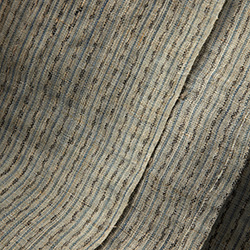

Kimon
This is a stylish kimono which is woven skillfully with hemp threads. It is believed that the cloth called Takamiya-fu during the Edo period is the antecedent of modern Oumi- Jofu, which was woven in Shiga prefecture.
Edo period
This is a stylish kimono which is woven skillfully with hemp threads. It is believed that the cloth called Takamiya-fu during the Edo period is the antecedent of modern Oumi- Jofu, which was woven in Shiga prefecture.
Edo period
オクソザックリ

本来は草である大麻を糸にする工程は、とてつ
なく複雑で時間を要する作業
である。刈り取り、皮剥ぎ、一本ずつ細く裂き、繋げていくその過程で大量に
屑が発生する。
人々はその「屑」でさえも捨てずに、再利用していた。
「オ」は糸になる前の大麻を指す。「クソ」は屑を意味する。「ザックリ」は
「サックリ」という仕事着の名からきていると推測されるが定かではない。
大麻は古代から 全国で栽培され、人々の生活の中で糸や布として使われてい
たので、オクソもどこでも発生してさまざまな再利用がなされていたと思う
が、オクソと特定されるものは少ない。
本来は草である大麻を糸にする工程は、とてつ
なく複雑で時間を要する作業
である。刈り取り、皮剥ぎ、一本ずつ細く裂き、繋げていくその過程で大量に
屑が発生する。
人々はその「屑」でさえも捨てずに、再利用していた。
「オ」は糸になる前の大麻を指す。「クソ」は屑を意味する。「ザックリ」は
「サックリ」という仕事着の名からきていると推測されるが定かではない。
大麻は古代から 全国で栽培され、人々の生活の中で糸や布として使われてい
たので、オクソもどこでも発生してさまざまな再利用がなされていたと思う
が、オクソと特定されるものは少ない。
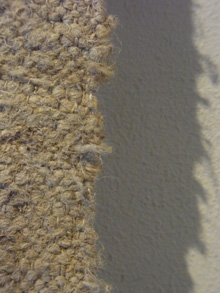
Okusozakuri,Hemp
Hemp cultivation was widespread in old Japan and hemp was a staple material. Creating thread from hemp is an incredibly complicated process. A great deal of waste is generated during the production. Hemp waste is called okuso. The “o” in the word okuso means “hemp” before it is processed into thread. “Kuso” means waste. Okuso was probably recycled in various ways. Nowadays, very few things are recognized as okuso clothes.
Hemp cultivation was widespread in old Japan and hemp was a staple material. Creating thread from hemp is an incredibly complicated process. A great deal of waste is generated during the production. Hemp waste is called okuso. The “o” in the word okuso means “hemp” before it is processed into thread. “Kuso” means waste. Okuso was probably recycled in various ways. Nowadays, very few things are recognized as okuso clothes.
オクソザックリ 仕事着
たて糸:大麻糸 よこ糸:オクソで紡いだ糸
オクソは短い繊維なので、木綿のように紡いで糸にすれば、よこ糸に使用でき た。 木綿の布が手に入らない時代には、よこ糸だけでも、柔らかく風を通しにくい 糸を使える事はありがたい事であったと想像される。
このようによこ糸に使われていた例は、明治から昭和初期ぐらいのものが福 井、石川、新潟県周辺で見つかるのみである。
おそらくもっと以前は、先に述べたように、全国的に大麻栽培はなされていた ので、さまざまな地方で作られていた可能性はあるが、文献などもなく、忘れ 去られたのであろう。
たて糸:大麻糸 よこ糸:オクソで紡いだ糸
オクソは短い繊維なので、木綿のように紡いで糸にすれば、よこ糸に使用でき た。 木綿の布が手に入らない時代には、よこ糸だけでも、柔らかく風を通しにくい 糸を使える事はありがたい事であったと想像される。
このようによこ糸に使われていた例は、明治から昭和初期ぐらいのものが福 井、石川、新潟県周辺で見つかるのみである。
おそらくもっと以前は、先に述べたように、全国的に大麻栽培はなされていた ので、さまざまな地方で作られていた可能性はあるが、文献などもなく、忘れ 去られたのであろう。
Okusozakkuri Work wear
Okuso is a short fiber. When the fiber is spun into thread, as cotton is, it would be used as weft.
Common people were very grateful to have okuso weft, a thread that was soft and pliable enough to be woven tightly, which produced a cloth that provided warmth when cotton cloth was not available.
The use of okuso weft was found only in Fukui, Ishikawa and Niigata prefectures from the Meiji period (1868 - 1912) to the beginning of the modern Showa period (1926 - 1989).
The method of making okuso cloth might have been forgotten were it not a small production that still continues today, as there were no written documents left behind.
Okuso is a short fiber. When the fiber is spun into thread, as cotton is, it would be used as weft.
Common people were very grateful to have okuso weft, a thread that was soft and pliable enough to be woven tightly, which produced a cloth that provided warmth when cotton cloth was not available.
The use of okuso weft was found only in Fukui, Ishikawa and Niigata prefectures from the Meiji period (1868 - 1912) to the beginning of the modern Showa period (1926 - 1989).
The method of making okuso cloth might have been forgotten were it not a small production that still continues today, as there were no written documents left behind.
Copyright 2002 Gallery Kei. All rights reserved.
